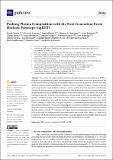| dc.contributor.author | Emami, Razieh | |
| dc.contributor.author | Anantua, Richard | |
| dc.contributor.author | Ricarte, Angelo | |
| dc.contributor.author | Doeleman, Sheperd S. | |
| dc.contributor.author | Broderick, Avery | |
| dc.contributor.author | Wong, George | |
| dc.contributor.author | Blackburn, Lindy | |
| dc.contributor.author | Wielgus, Maciek | |
| dc.contributor.author | Narayan, Ramesh | |
| dc.contributor.author | Tremblay, Grant | |
| dc.contributor.author | Alcock, Charles | |
| dc.contributor.author | Hernquist, Lars | |
| dc.contributor.author | Smith, Randall | |
| dc.contributor.author | Liska , Matthew | |
| dc.contributor.author | Natarajan, Priyamvada | |
| dc.contributor.author | Vogelsberger, Mark | |
| dc.contributor.author | Curd, Brandon | |
| dc.contributor.author | Kramer , Joana A. | |
| dc.date.accessioned | 2023-01-20T15:22:11Z | |
| dc.date.available | 2023-01-20T15:22:11Z | |
| dc.date.issued | 2023-01-10 | |
| dc.identifier.uri | https://hdl.handle.net/1721.1/147588 | |
| dc.description.abstract | We explore the plasma matter content in the innermost accretion disk/jet in M87* as relevant for an enthusiastic search for the signatures of anti-matter in the next generation of the Event Horizon Telescope (ngEHT). We model the impact of non-zero positron-to-electron ratio using different emission models, including a constant electron to magnetic pressure (constant <inline-formula><math xmlns="http://www.w3.org/1998/Math/MathML" display="inline"><semantics><msub><mi>β</mi><mi>e</mi></msub></semantics></math></inline-formula> model) with a population of non-thermal electrons as well as an R-beta model populated with thermal electrons. In the former case, we pick a semi-analytic fit to the force-free region of a general relativistic magnetohydrodynamic (GRMHD) simulation, while in the latter case, we analyze the GRMHD simulations directly. In both cases, positrons are being added at the post-processing level. We generate polarized images and spectra for some of these models and find out that at the radio frequencies, both of the linear and the circular polarizations are enhanced with every pair added. On the contrary, we show that, at higher frequencies, a substantial positron fraction washes out the circular polarization. We report strong degeneracies between different emission models and the positron fraction, though our non-thermal models show more sensitivities to the pair fraction than the thermal models. We conclude that a large theoretical image library is indeed required to fully understand the trends probed in this study, and to place them in the context of a large set of parameters which also affect polarimetric images, such as magnetic field strength, black hole spin, and detailed aspects of the electron temperature and the distribution function. | en_US |
| dc.publisher | Multidisciplinary Digital Publishing Institute | en_US |
| dc.relation.isversionof | http://dx.doi.org/10.3390/galaxies11010011 | en_US |
| dc.rights | Creative Commons Attribution | en_US |
| dc.rights.uri | https://creativecommons.org/licenses/by/4.0/ | en_US |
| dc.source | Multidisciplinary Digital Publishing Institute | en_US |
| dc.title | Probing Plasma Composition with the Next Generation Event Horizon Telescope (ngEHT) | en_US |
| dc.type | Article | en_US |
| dc.identifier.citation | Galaxies 11 (1): 11 (2023) | en_US |
| dc.contributor.department | Massachusetts Institute of Technology. Department of Physics | |
| dc.contributor.department | MIT Kavli Institute for Astrophysics and Space Research | |
| dc.identifier.mitlicense | PUBLISHER_CC | |
| dc.eprint.version | Final published version | en_US |
| dc.type.uri | http://purl.org/eprint/type/JournalArticle | en_US |
| eprint.status | http://purl.org/eprint/status/PeerReviewed | en_US |
| dc.date.updated | 2023-01-20T14:22:44Z | |
| dspace.date.submission | 2023-01-20T14:22:44Z | |
| mit.license | PUBLISHER_CC | |
| mit.metadata.status | Authority Work and Publication Information Needed | en_US |
